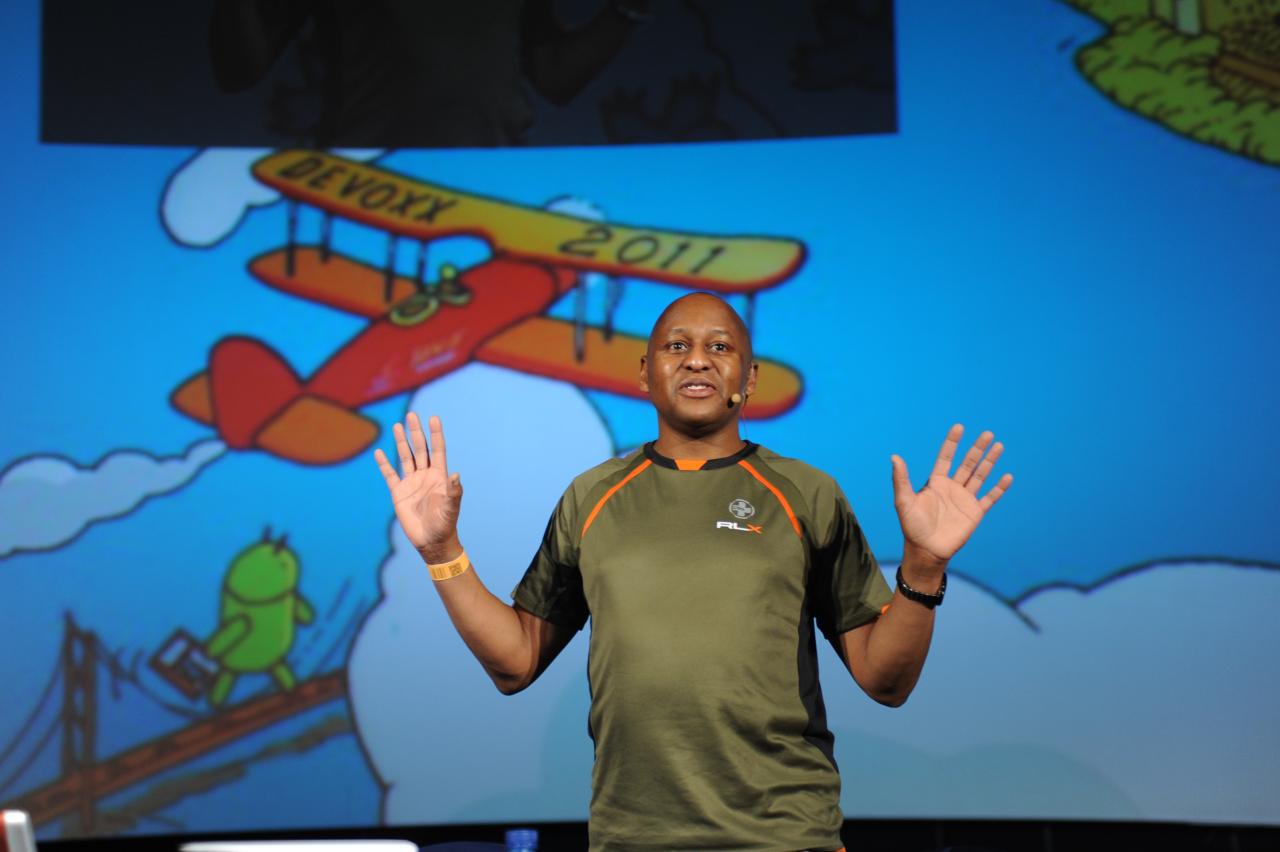JavaOne 2010 Alternative JVM Languages including JavaFX
21 September 2010 Comments off
Reading time:
8 minutes
Word count:
1670
JavaOne 2010 Alternative JVM Languages including JavaFX
|
“Look at the way Microsoft delivers it new products, for example SilverLight, Expression Blend or Visual C# IDE. Every new product that Microsoft produces come with a tool [tooling], that is the Microsoft way and we [Oracle] have to learn how from that [business] model.” |
An Opportunity to meet Apolo Anton Ohno, eight Olympic medallist backstage of the Moscone Center
Schedule
My theoretical schedule consisted of
9/20/10 – 10:00 AM – JDK 7 and Java SE 7 – Hilton San Francisco – Grand Ballroom AB
9/20/10 – 10:00 AM – JavaFX 2.0 – Hilton San Francisco – Golden Gate 6/7
9/20/10 – 11:30 AM – JavaFX: Designer Developer Workflow – Hilton San Francisco – Golden Gate 8
9/20/10 – 1:00 PM – What’s New in Grails 1.3? – Hilton San Francisco – Yosemite C
9/20/10 – 2:30 PM – Funky Java, Objective Scala – Parc 55 – Cyril Magnin I
9/20/10 – 4:00 PM – Clojure’s Approach to Identity, State, and Concurrency – Parc 55 – Cyril Magnin I
9/20/10 – 4:00 PM – JavaFX Your Way: Building JavaFX Applications with Alternative Languages – Hilton San Francisco – Golden Gate 8
9/20/10 – 7:30 PM – The Groovy and Grails BOF, with Live Grails Podcast Recording – Moscone South – Rm 307
9/20/10 – 9:30 PM – Dependency Injection (DI) Flavors in Spring 3 – Moscone South – Rm 303
I have highlighted the sessions in bold that I manage to attend. I did get to see to a Visual VM BOF and Kirk Pepperdine Performance Tuning in Java BOF last night. Gosh! Fatigue, finally, did set in so late into the evening, I admit it rather strongly. However Kirk was on good form and it was another damn fine presentation on Java Performance Tuning successfully delivered to high standards. Kirk presented to the JAVAWUG in 2008 and it was extremely popular.
On the right, Richard Bair, and middle is Jasper Potts
JavaFX Script: “I Am Not Dead Yet?”
You probably are already aware that JavaFX Script is no longer to be developed, by Oracle Corporation, beyond JavaFX 1.3.1 release. This is a cost-benefit decision and purely pragmatic business decision. JavaFX is now re-branded to be solely an Java Library and Framework API. I believe in the long term that Oracle has made a very wise decision. They are looking at the long-tail of computer development, especially in the consumer electronics and portable device space. It is known that there these is enormous emerging untapped market in mobile phones, and also today’s technology in smart phone will descend down into feature phones. JavaFX is a client side technology, so they are going aggressively to the TTM (Time-to-market) launch and also answering in one fell swoop two questions that have always been difficult to respond regarding JavaFX Script. [Personal disclosure: yours truly has been aware of Oracle’s decision to change JavaFX 2.0 into a library framework for a few weeks now.]
Two Fundamental Questions Answered Today
How can I integrate JavaFX with existing Swing applications? You have an answer now. JavaFX will be ported to Java. All of the current existing features of the JavaFX runtime and language, version 1.3.1, the scene graph, the ability to bind between object properties will have a [as yet forthcoming] Java API. You will be able to create a JavaFX Stage in Java and add scene-graph components and layout containers into it. For a few short years, then, Swing and JavaFX for Java APIs will exist side-by-side for enterprise development. However, the release of PRISM render graphics pipeline, means that Swing UI eventually be phase out, because it is depends heavily on the current AWT (Abstract Windowing Toolkit) technology.
How can I use JavaFX Script with an alternative JVM languages? You also have the second answer now. Oracle’s long tail solution, and this is evidence of their business management exploring decisions and strategies about the existing JavaFX product, in it shot it is to reinforce the mother language, which is Java. By providing a Java API, a library and framework, which allows mainstream Java developers to invoke JavaFX Script current features, then therefore these incredible iPhone/iPad animated graphics features are immediately available to other alternative JVM languages, including: JRuby, Clojure, Groovy and, best of all, Scala. I am incredibly pumped up that I could get Scala and FX features working together extremely soon.
New Business Model
In summary, paraphrasing Oracle’s official slides: Java is the next primary language in JavaFX 2.0. Binding and sequences will be available as Java APIs, in particular Sequences are expected to be a special Java collection type. Oracle is emphasising the ability to embrace all JVM languages to use FX. Unfortunately the JavaFX Script language wont be updated to FX 2.0 library, however we, the JavaFX community, have asked for it to be completely handed over to an open source personality. Existing JavaFX 1.3 programs will continue to run on the next runtime. [However your mileage may vary after the furthers updates on the JavaFX 2.0 product line. Stephen Chin has an important announcement for JFXtras concerning JavaFX Script language].
During Larry Ellison opening keynote on Sunday, JavaOne delegates were at Hilton Hotel venue to see the live video stream of the event. I had to a chance to meet with Brian Goetz whilst the keynote video wall was playing. I spoke to him, he talked about JavaFX as Java API library framework, the reason for Oracle’s decision to no longer evolve JavaFX Script and rebrand JavaFX into a Java library framework was because “lack of resources and we needed a considerable amount of time to build adequate tooling”. Brian said that, “Look at the way Microsoft delivers it new products, for example SilverLight, Expression Blend or Visual C# IDE. Every new product that Microsoft produces come with a tool [tooling], that is the Microsoft way and we [Oracle] have to learn how from that [business] model.”
The Future of JavaFX
Oracle intends to evolve JavaFX 2.0 from the current FX 1.X product line. As for JavaFX Script the scene graph, expression language and event model are mostly feature complete. So they aim to provide Java analogues of the current programming model, maybe they might consider the builder object idiom to cope with JavaFX Script declarative syntax will be missing. The current implementation of JavaFX stylesheets and styling of components using HTML / CSS will be ported to new JavaFX 2.0 for Java API
Oracle realises it needs to recruit additional high-calibre good Java API designers / engineers. They intend to release early, provide beta releases to key partner. They also intend to create build blueprints, samples, and demos in parallel. They clearly want to show JavaFX is intended for the enterprise and at this conference, at least, talked a very good game, of supporting the mainstream developers and engineers get into JavaFX. Make no mistake, this is the change the user desktop community have been looking for, JavaFX 2.0 effectively is the new way to develop modern user interface application. Oracle has published a Roadmap for JavaFX 2.0.
There is one question that I did not see answered at the keynote, which was absolutely fantastic for demonstrating the latest PRISM graphics pipeline. What has happened to the designer/authoring tool? There were slides on the developer and designer work flow shown at the event, however strangely there was no announcements regarding authoring tool, which we last saw demonstrated at JavaOne 2009 and Devoxx 2009. I believe authoring tool was being developed using JavaFX Script. If you know the truth and what happened to the authoring tool, please let us know
Here is the verbatim slides information, which I dictated into Notepad++.
Developer oriented workflow
RAD tool, SVG import, UI CSS
Designer ” “
Designer produces media assets
Developer produce modules (e.g. access web services)
Designer aggregates assets, graphics images, code modules & scripts using JavaScript or another
dynamic language
Web Integration with JavaFX
Embed HTML in JavaFX
WebBiew node in the scene graph is embedded browser
Allow all Text nodes to have HTML content
Seamless DOM integration
Embed JavaFX in HTML
using traditional plugin technology
Seamless DOM integration
Adapt to use HTML 5, local storage, browser history, etc
Adopt more web standards
Improve CSS and add accessibility for HTML
Graphics
2D and 3D scene graph
DirectX 9 on Windows XP, Vista
DirectX 11 on Windows 7
OpenGL on Mac, Linux, Embedded
Software (Java2D) when necessary
Hardware accelerated pipeline
Embed in Swing
c.f Java3D, JOGL
Allows Swing applications to add JavaFX scenes, charts, media and controls
High Definition Media
Controls
Simple, Rich, Useful
Highly customisable via CSS
Visually appealing
Complete working out of the box
Data binding and tooling
Performance Small & Fast
Measure, measure, measure
AudioBoo Related Information
Please go and visit my specific website https://audioboo.fm/peter_pilgrim
Java Champions and Networking Opportunities
Here are some photographs around the time we were gathered to me up with Apolo Anton Ohno, the celebrated American Olympic speed ice skater. We all had to a chance to see the amazing set up Audio/Visual equipment to goes into making a keynote presentation for JavaOne, Oracle Open World.
Dr. Heinz M. Kabutz (left), originally from South Africa, lives in the lovely mediterranen Island of Crete. Dr. Heinz is at JavaOne 2010, his first conference, unbelievably for the very first time ever; Middle is Dr. Fabiane Bizinella Nardo, winner of the Duke award for Brazilian Healthcare Information System; and Right is Stephen Colebourne of Closures for Java, FCM fame and also JodaTime.
This is Peter Pilgrim, who in San Francisco for the JavaOne 2010 conference. Out
20/September/2010



